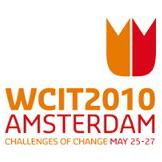Category: Government 2.0
Mapping the Political Contours of Cyberspace
William Gibson coined the term “cyberspace”, for his 1982 short story Burning Chrome to create a “a narrative engine, and a territory in which the narrative could take place”. Twenty years on, cyberspace is the world’s narrative engine: and an uncharted territory to which the world is still coming to terms.
Political, industrial, and civic leaders are gathering at the Foreign Office’s London Conference on Cyberspace next week to think through the implications, opportunities and contradictions of this emerging world.
The conference will explore key themes – prosperity; social good; freedom of access and expression; cyber crime and international security – with the aim of deepening mutual understanding and beginning to outline a political, social and economic strategy to secure the benefits of cyberspace while addressing the concomitant threats to personal and national security.
The Foreign Office would like the dialogue at the event and online to be as broad as possible – and, in support of this process, Debategraph will be mapping and curating the dialogue as it unfolds live and online.
To start exploring the map – which we have seeded with the initial framework of the conference – click on the small bubbles to move deeper into the debate and on the larger bubbles to move back up.
You can gain an insight into the range and scope of the debate by watching the map evolve here, but you are welcome to add your voice to the debate online by adding new ideas and comments to the map and by rating the ideas, or by suggesting new ideas and questions via Twitter using the #LondonCyber hashtag and/or the Foreign Secretary’s Facebook channel (both of which we will be monitoring as well).
As discussed before, the whole structure of the map is like a wiki – every aspect is provisional, and open to further refinement – and everyone can add new issues, positions, arguments and evidence to the map.
The aim is to weave together all of the arguments into a rich, transparent, non-linear structure that anyone can explore and understand quickly.
As with the other maps in the The Independent series you can keep up to date with developments via @TheIndyDebate on Twitter, and you are welcome to embed the map (like a YouTube video) on your own site or blog using the code shown below:
*Cross-posted at: The Independent
Controlling Persistent Infectious Diseases
The first in a quick series of posts to catch-up on some of our projects in 2011 so far.
At the start of March 2011 I was privileged to map a 5-Day workshop on “Modelling and analysis of options for controlling persistent infectious diseases” at the Banff International Research Station for Mathematical Discovery and Innovation; part of the breathtakingly beautiful Banff Centre in Alberta, Canada.


The workshop gathered 40 leading mathematical modellers, infectious disease researchers, clinicians and public health officials from around the world to explore the past and future contribution of the mathematical modelling to public health policy, the priorities for future research, and potential ways to enhance the relationship between the research community and public health officials.
Debategraph was used throughout the five-day workshop to the map the live discussions and to facilitate the group dialogue around the key points arising – with group members contributing directly to the map as the workshop proceeded.
The map resulting from the discussions – which the group is continuing to develop beyond the workshop – is embedded below:
Mapping the Amsterdam Declaration
The World Congress on Information Technology 2010, which began in Amsterdam earlier today, brings together over 2,000 leading figures from industry, government, and academia from over 90 countries to address the global challenges of economic, environmental and social development.
The speakers include: Paul Otellini(Intel), Stephen Elop (Microsoft), Pierre Hessler (Capgemini) , Michael Fries (Liberty Global), Neelie Kroes (Commissioner Digital Agenda European Commission), Martin Lees (Secretary-General Club of Rome), Francisco Ros Perán (Secretary of State for Telecommunications, Spain), Tony Clement (Canadian Minister of Industry), Datuk Seri Ongkili (Federal Minister of Science, Technology and Innovation, Malaysia), Kumar Parakala (KPMG), Peter Sondergaard (Gartner), Virginia Rometty (IBM), Sachin Pilot (Ministry of Communications and Technology, India), Maria van der Hoeven (Minister of Economic Affairs, Netherlands), Sylvia Roelofs (ICT-Office), and William Kennard (US Ambassador to the European Union).
The conference is building towards the Amsterdam Declaration, which calls on all participants to pursue ambitious goals for the use of information technology in addressing economic growth, greenhouse gasses, the quality of life, and ensuring the global impact of these benefits.
All organisations supporting the Declaration of Amsterdam are asked undertake at least one major project in the spirit of the Declaration, and to report back on its progress and achievements at WCIT 2012 in Montreal.
As part of this process, Debategraph is working with the conference to map the Amsterdam projects and their relationships to the overarching goals – with the work-in-progress covering around 60 projects from around the world shown below:
You can follow the proceedings of the conference across the next three days live here and on Twitter via the hashtag: #WCIT2010.
Dissecting the Conservative – Liberal Democrat Coalition Agreement
As part of The Independent’s visual mapping of the election and its aftermath, we have broken down the Conservative – Liberal Democrat Coalition Agreement into an interactive visual graph that lets you comment on and rate each of the proposals.
By surfacing their shared agenda for the next Parliament explicitly in this way, the Conservatives and the Liberal Democrats have given the electorate an unusually swift and detailed opportunity to give feedback on the proposals they have drawn together in our name.
Both parties have also indicated the desire to open public policy deliberation to wider public input online during the coming parliament; so it’s a timely opportunity as well to consider to what degree—under the intense pressure they faced and in a closed rather than an open process—the party negotiating teams were able to find an agreement close to a mutual optimum.
As well as rating and commenting, you can use the interactive graph to add arguments for and against the Coalition proposals and to suggest alternative ideas that might have been missed.
So, in the new spirit of collaboration, what do you make of the agreement?

